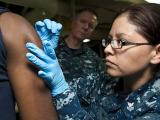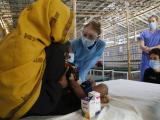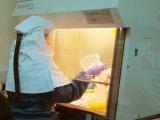Feb 19, 2002 (CIDRAP News) – Three case reports from the recent anthrax outbreak published in the February 20 issue of the Journal of the American Medical Association demonstrate that even patients without obvious anthrax exposure may be at risk, pointing up the need for heightened public health surveillance and increased public awareness.
The case of the 61-year-old New York woman with fatal inhalational anthrax is reported by Bushra Mina, MD, and colleagues from Lenox Hill Hospital in New York City. No source of anthrax exposure has been identified despite epidemiologic investigation. "It has been postulated that infection from a cross-coitaminated envelope may have been the source of anthrax transmission . . . However, it is unclear why she is the only patient in New York City to date who has developed inhalational anthrax," the authors state.
The case of the 94-year-old Connecticut women who died of inhalational anthrax from an unidentified source is reported by Lydia Barakat, MD, from Griffin Hospital in Derby, Connecticut, and colleagues from the same hospital, the Centers for Disease Control and Prevention (CDC), Emory University, and the Connecticut State Medical Examiner's Office. "Exposure to mail that was cross-contaminated as it passed through postal facilities contaminated with B anthracis spores is one hypothesis under investigation," they say. They conclude their report by pointing out that "New approaches to early diagnosis and more effective treatment of the pulmonary complications of inhalational anthrax are clearly warranted."
Abigail Freedman, MD, and colleagues from New York University School of Medicine, New York, report the case of the 7-month-old infant with cutaneous anthrax. The source is thought to be the workplace of the infant's mother, which the infant visited the day before the onset of symptoms. The case was complicated by quick progression to severe microangiopathic hemolytic anemia despite early antibiotic treatment. The authors state that if the diagnosis is suspected, "The patient should be admitted to the hospital, electrolyte and hematological status should be monitored carefully, and intravenous antibiotics should be instituted."
In an accompanying editorial, Julie Gerberding, MD, MPH, and coauthors from CDC discuss the critical role of clinicians in all phases of bioterrorism preparedness response programs and the importance of ongoing collaboration between clinicians and public health agencies. In their words, "Hopefully, the lessons learned during the past four months will motivate local health departments, health care organizations, and clinicians to engage in collaborative programs to enhance their communication and local preparedness and response capabilities."
Mina B, Dym JP; Kuepper F, et al. Fatal inhalational anthrax with unknown source of exposure in a 61-year-old woman in New York City. JAMA. 2002;287:858-62
Abstract Full text
Barakat LA, Quentzel, HL, Jernigan JA, et al, for the Anthrax Bioterrorism Investigation Team. Fatal inhalational anthrax in a 94-year-old Connecticut woman. JAMA 2002;2287:863-7
Abstract Full text
Freedman A, Afonj O, Wu Chang M, et al.Cutaneous anthrax associated with microangiopathic hemolytic anemia and coagulopathy in a 7-month-old infant. JAMA 2002;287:869-74
Abstract Full text
Gerberding JL, Hughes JM, Koplan JP. Bioterrorism preparedness and response: clinicians and public health agencies as essential partners. JAMA (Editorial) 2002;287:898-900
Full text


















